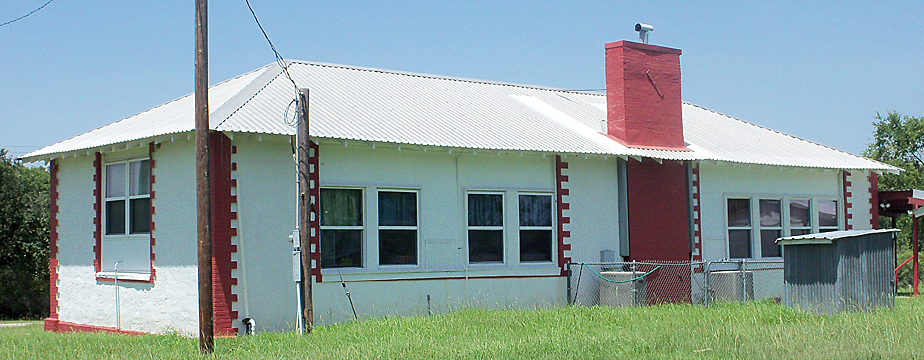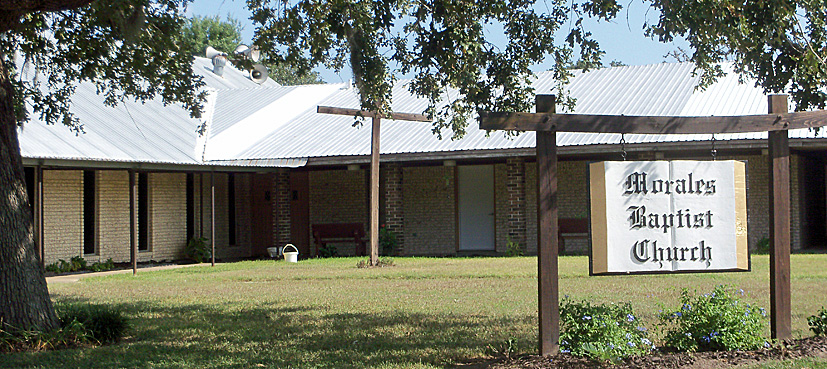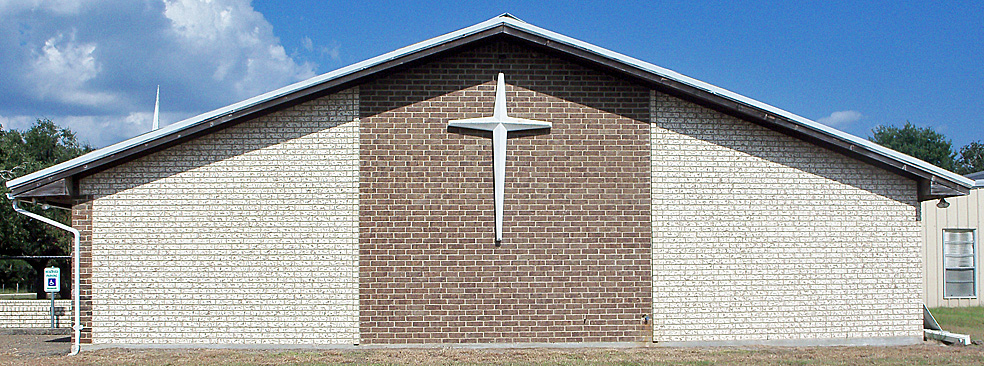|
|
|||||||||||||||||||||||||||||||||||
|
Morales |
|||||||||||||||||||||||||||||||||||
|
|
|||||||||||||||||||||||||||||||||||
|
|||||||||||||||||||||||||||||||||||
|
Morales is a very old community and probably next to the oldest town in Jackson County, Texana. It was a thriving village long before the Civil War. This community was on the J. Vess league which was granted by the Mexican government to Jonathan Vess. This little village was named after a Spaniard, who started the village by building a blacksmith shop. The community grew from this shop to a post office and store in a short time, all located on the same tract of land, including the Masonic hall. At the close of the Civil War, about 1870, Morales was quite a thriving community. More stores had been added, a drug store, two or three saloons, a gin and a telegraph office. This telegraph office was the first in Jackson County, the wires being strung in 1870 between Columbus and Victoria. Morales was the only station between these cities. A Mr. Spruce owned the first telegraph office and his half brother, Mr. Gerrard was the first operator. Frank Morales owned the first blacksmith shop, Dr. P. K. Miller was the first doctor and owned the first drug store. Joel Wingfield and Mr. Garrett, first postmaster; Miss Gustie among the first teachers; C. C Moore owner of the first cotton gin, gristmill and saw mill, and Del Rodgers, owner of the first store. Others who owned the store were as follows: Mrs. Bock, John Knopp, Herman Lochausen, Henry Strane, Frank Ball and Charlie Boles, others from 1936 have operated the store until the present time (1967), Mr. D. J. Jordan owns it. Mr. W. W. Moore of Houston has this to say about the times at Morales. Being a native of Morales he had these stories almost first hand: "Morales in the early days was quite a wild place and the records of Jackson County will show that possibly more men were killed in fights in that community than in any other place in the county. It became so notorious at one time that people passing through, before they reached Morales would inquire the distance to Morales and ask if there wasn't some way they could drive around the village. In one of the old homes, you could examine the west wall of the room on the southeast corner and you would find a large dark stain--it was made from blood. It seems that a man was arrested for some misdemeanor at Texana and was to be placed in jail there, but the Deputy Sheriff stopped with the prisoner and attended a dance at Morales. In order that his prisoner not escape he handcuffed him to a chair and placed him next to the wall. During the dance an enemy of this man (at that time nearly everyone in Morales had enemies) slipped to the south window and blew his head off with a double-barreled shotgun. Naturally, no one know who had done the killing. Many such stories have been related and most of them have been authenticated. Nearly all of the oddest stories have a background of truth, even though some might be slightly exaggerated. The important thing about this old store is that it still looks much the same as it did at the time that Morales was in its prime of life. All of the people used the store at that time as they do today, as the gathering place, even more than they did the church and schools, due to the fact that many of the inhabitants did not go to church or were too old to go to school. Nobody was too old, too good or too bad to go to the community gathering place of Morales, the Grocery Store, then a General Merchandise Store. It has taken on a white paint front but otherwise it is the same old store in a quieter surrounding, even though until a few years ago, it was still considered out of bounds at different gatherings that were held in those parts. The architecture could be termed "Early Morales and Early Jackson County." Brush arbors were erected near the store and people came for miles around for camp meetings, however the first church established was the Methodist, but until recent years no building was ever erected. Mr. W. W. Moore of Houston, still owns ranches in the Morales community. "It seems that the men of Morales really got around. In the early sixties there was an old Grimes? hide and tallow factory that was located between Texana and Port LaVaca. The citizens of Morales were losing cattle by the hundreds as well as a great number of fine horses. They held a mass meeting and formed a vigilant committee to find out what was becoming of their livestock and punish the guilty parties. The cattle thieves sold these cattle at one dollar per head for their hide and tallow and the committee hung several of the thieves to end the depredation to their livestock. Rev. Johnny Cook and many other pioneer preachers went along to pray for the thieves and to sing the Doxology after they were hanged. Some of the older people have told their descendants that the Dalton Boys came from Missouri as an outcrop of the Civil War. One day while a Methodist revival was going on, it was told that the Dalton Boys were in Morales. With all the wailing and crying of the women and children, and probably some of men, the braver ones went off on the man hunt, not finding the Dalton Boys. The Boys really did come through Morales and LaVaca County, hiding in what was known then as the "Devil's Pocket" on the Navidad River.
More stories come to mind with the telling of
others, but it all leads back to the center of attraction in the
town, the Old Morales Store. |
|||||||||||||||||||||||||||||||||||
|
Old Morales School Old Morales School and patrons are shown in this photograph of 1907 owned by Mrs. A. L. Lincecum of El Campo. It’s another in a series being published by The Herald for the edification of our readers. Practically every person in the photo has been identified by Mrs. Bertha Whittington of Edna. The little fellow at the left in the front row is Ed Partridge. The teacher was Angie Thomas. Among those shown are Boon Whittington, Tim Partridge, Sadie Milby, May Hubbard, Edd Smothers, Otto Lochausen, Bob and Daisy Flournoy, Ann, Naith, Lea and Tip Gandy, Bill and Rovilla Budd, Bertha Whittington, Lee Chaney, Harvey Gandy, Ernest Knopp, Rhea Whittington, Fanny and Ruth Partridge, Clara Flournoy, Genieve Gandy, Archie Laughter, Mary Strane, Celesta Laughter, Bicy Miller, Dale Whittington, Kelley Smothers, Daisy Laughter, Annie Budd, Lucille Strane, Robert Flournoy, Maud Shows and Cecil Flournoy.
Edna Herald, February 3, 1955 |
|||||||||||||||||||||||||||||||||||
|
Morales Grammar School 1920 - Morales Community Center July 20, 2015  |
|||||||||||||||||||||||||||||||||||
 |
|||||||||||||||||||||||||||||||||||
|
|
|||||||||||||||||||||||||||||||||||
|
|
|
|
|
|
|
Property for the church was donated by the Jansky
family. |
|
|
|
|
|
|
|
|
|
The Morales Baptist Church is talking on new life. The church is now holding its services in the school house and has been doing so all along. For this privilege the entire membership is profoundly grateful. A building and soliciting committee, consisting of Mr. Sid Williams, Mr. Earl Airhart, Mrs. Walter Partridge and Mrs. W. M. Fitch, has been duly appointed. Thus far the committee has received $1,192.54. An appreciable amount of this contribution has been graciously received from friends of the church. If there are other good friends who wish to help this worthy cause, see any member of the committee, or W. R. Gloor, church treasurer. Work on the building is contemplated as soon as building materials are available.
Edna Weekly Herald,
April 25, 1946 |
|
The Morales Baptists were a happy people Sunday, June 13th, for on that day they moved into their new building for an all day service with an old-fashioned basket dinner on the grounds, and dedication services in the afternoon. Rev. Martin Y. Rucker, former pastor, now pastor at Kemah, preached at both morning and evening services. It was during Bro. Rucker’s pastorate the move for a building was initiated. In the afternoon, prior to the dedication services, a song and prayer service, followed by a brief recognition service in which, 1st, all visitors were recognized; 2nd, recognition of all friends who helped in making the building possible, either by buying bonds or by direct contributions; and 3rd, recognition of our efficient building committee. The Dedication Sermon Pastor Carl J. Schlomach, Edna, preached the dedication sermon. It was an able, inspiring and soul-searching message. Pastor Martin Y. Rucker, Kemah, led in the dedication prayer. Then the church, standing in a body, solemnly made the following pledge; “We do, before God and this assembly, dedicate this house as a sanctuary holy unto God; and we promise, by the aid of the Holy Spirit to strive together for the advancement of this church in knowledge and spiritual power; to sustain its worship ordinances, and doctrines; and to contribute cheerfully to its support, the relief of the poor, and the spread of the gospel to all Nations.” For the week following the dedication services, Bro. Schlomach led us in a week’s revival in which the church was greatly edified and souls saved. There were eight additions—one by letter and seven by baptism. Mr. C. W. Boles, Edna, led the song service to the delight of all. In the absence of our pianist, Mrs. Mable Williams, Mrs. H. C. Davis, Mrs. H. Dunham, Miss Betty Volkmer and Frank Volkmer, Jr., all of Edna, were in turns at the piano. Miss Mildred Roberts, Edna, worked with the young people. T. D. Felts, Pastor.
Edna Weekly Herald, June 24, 1948 |









